
 |
So I'm sure many of the veteran forum fiends are sick and tired of these coilover threads from noobs (such as myself) that simply ask: "WHICH ONE IS BETTER!?" Every
|
|||||||
 |
|
|
LinkBack | Thread Tools | Display Modes |
|
|
#1 (permalink) |
|
A True Z Fanatic
 Join Date: Feb 2011
Location: Irvine
Posts: 1,682
Drives: 13 PW sport 6mt
Rep Power: 19           |
So I'm sure many of the veteran forum fiends are sick and tired of these coilover threads from noobs (such as myself) that simply ask: "WHICH ONE IS BETTER!?"
Every coilover brand has their own PR documents stating what a great suspension system they have and how revolutionary their technology is. Furthermore everyone on the forum has their own favorite brand of coilovers and opinion on which one feels the best. I have yet to hear someone buy a set of $1500 coilovers and say that it was worse than stock. Which brings me to my point. I don't just want to know about people's recommendation. A quick search will yield a ridiculous amount of threads with dozens of different answers. I want to know WHAT TO LOOK FOR. What MAKES a coilover system better than the other. Why is Tien better for one application and Apexi better for another? I think it would be really helpful for everyone if we could educate noobs (once again, such as myself) on the merits of a proper coilover system and also what makes one more expensive than another. Now I know that suspension setup is different based on application so lets get views on them all: DRIFT TIME ATTACK AUTO-X STREET (your average road warrior) Are all coilovers within a price range acceptable and it simply depends on how you tune it? Is the price difference simply because of adjustability? Now I'm aware of another thread with a lot of technical information on coilover construction and it had a lot to say regarding street vs. track coilovers regarding mono-tube vs. the other kind (can't remember off the top of my head). Though the technical aspects of the contruction of a coilover was exhaustive and interesting, it's been difficult for me to apply that knowledge toward an educated purchase when actually choosing a coilover brand. I apologize in advance for the broken thought process, I'm just typing all of this out as I go. I will come back and edit when appropriate. Last edited by dP3NGU1N; 02-21-2013 at 12:32 PM. |
|
|

|
|
|
#2 (permalink) |
|
A True Z Fanatic
 Join Date: Nov 2011
Location: Houston
Posts: 12,265
Drives: 2011 370ztt
Rep Power: 29539            |
I'm of the opinion that any of the top-tier brands of coilovers will give you pretty much the same results. There's going to be differences in damping and adjustibility, but for the non-track user it's almost an academic difference. In my opinion, for someone who doesn't want to track their car, a good set of springs and struts will be more in line with what you need. If that won't lower the car enough, then I'd argue that you want to lower it too much and throw the suspension geometry all out of whack.
Budget coilovers are a different story. These all seem to be made in China or Taiwan, with little or no quality control. Material quality is suspect to say the least. I've seen shock dynos of cheapo coilovers and none of them matched each other, not to mention that each "click" of adjustment was not consistant between units. This is going to cause issues when one corner of the car reacts differently to inputs than another. My recommendation for coilovers is to buy ones that use damper brands you've heard of. Many of the JDM coilovers use brands like KYB, Bilstein, etc. Make sure that you can easily have them rebuilt without shipping them halfway around the world and waiting on them for months. I'm not too crazy about the coilover setups that relocate the rear spring, but others have had no issues with it. I'd expect a set of known good coilovers to start at $2000 on up. If you want to go really crazy, go see if Moton or Penske makes a set of coilovers for a Z.
__________________
2011 MB Touring-Sport-6sp-Nav/GTM TT/FI TT TDX/JTran/Kosmic/Eibach/Hotchkis/SPC/CSF/RPS/SoThatsWhereAllMyMoneyWent |
|
|

|
|
|
#3 (permalink) |
|
Base Member
Join Date: Sep 2012
Location: Lebanon
Posts: 159
Drives: Volvo T5-R
Rep Power: 13    |
There is always a ton of talk on car forums about mono-tube vs twin-tube and coil-over vs spring-shock and I figured I would go ahead and post my thoughts on the subject given what I have learned over years of both street tuning and racing.
I was going to post a long thread about this but I think Tein does a better job then I ever could do but I want to add a few additions on the subject. However, I would like to add a few important things for you to keep in mind before you read the article from Tein. After reading this article my respect for Tein has jumped about 100 fold since they seem to be the only company that tries to really inform customers. The first thing is this article really keeps in mind the best possible scenario for mono-tube shocks. I want to add that not all mono-tubes are built the same because they have different goals to achieve. However, what it doesn't tell you is that mono-tubes have some serious downsides for the street that I think should be addressed. The first is that cheap mono-tube solutions Bilstein/KYB shocks or cheap coil-overs is that they are built for the street. This means they need work over a long period of time compared to a racing shock. The average racing shock gets re-pressured at the very least before every racing weekend so they might need to work at optimal levels for a few days. The street mono-tube must work at optimal levels for years meaning that gas pressure has to be retained inside the floating piston. To do this they have to run significant amount of sealing on the floating piston so they shock will be durable to street use. The downside to this is that a floating piston with high sealing surface friction or stiction significantly reduces the shocks ability to deal with small amplitude and high frequency response and this is the real reason they ride so rough. The cheap mono-tube also runs high pressure. I have read that bilstein runs around 360lbs of pressure in there shocks. In a racing shock from AST or Moton on the track I run usually between 100-200lbs of pressure so you can see its almost double a racing shock. This means that resistance inside the oil is going to be higher and we see this on some racing shocks (Penske) but keep in mind they are valved for it. Bilstein does it so the shock will last longer and to keep the shock working relatively decently over the large pressure change the shocks will see during there lifetime they use divergent valving. This amazingly is the real reason for divergent valving and its a damn impressive solution but its not the advertising they would like you to believe. The mono-tube life span even with all the extra seal friction and pressure is about three years and given all the drawbacks that these shocks and coil-overs deal with I always suggest a different solution for street cars. Also, since these shocks usually don't work as good as a twin-tube even on the track I usually suggest going with a twin-tube setup unless you have the budget to spring for a higher end coilover with nitrogen port so you can enjoy them for a very long time. Anyways for the following all credit goes to Tein and here is the link. TEIN, INC. | SPECIAL | Why TEIN is "Mono-Tube / Twin-Tube Construction" The structural differences between Mono-tube and Twin-tube. These are the Mono-tube and Twin-tube shock absorbers you often find in magazines etc. For those of you who have ever thought to yourself, “I think I know the differences in the structure, but what exactly is the difference?” Here is the explanation. 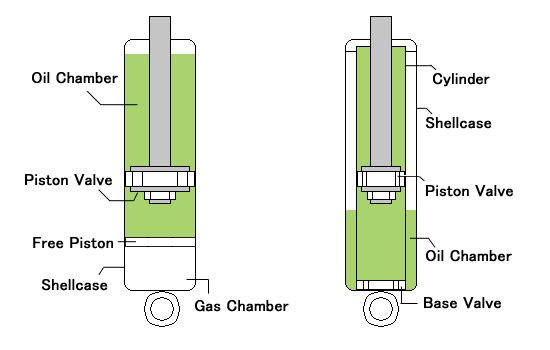 The main difference between Mono-tube and Twin-tube systems, as shown above, is the number of tubes used for the shock absorber. ♦ Mono-tube: the shell case itself works as a cylinder and oil, gas, piston valve, etc are all set in a single tube. ♦ Twin-tube: there is a separate cylinder set inside the shell case and the piston valve moves up and down within the inner cylinder. Other differences in construction. Mono-tube uses a free piston that completely separates the oil chamber from the gas chamber. While for the Twin-tube, nothing separates the oil and gas chambers within the shell case. The differences between Mono-tube and Twin-tube shock absorbers, is not simply the number of tubes but also the inner mechanism as well. Let’s have a look at the merits and demerits of the mono-tube shock absorber. 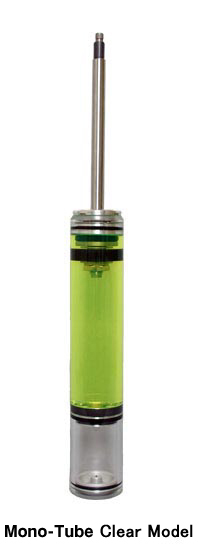 Merits *Stable damping force can be generated, because of the larger oil capacity and improved heat dissipation. *The larger sized piston valve creates a wider area to receive pressure, and even subtle damping force can be achieved. *The structure allows no restrictions in installation angles. *Oil radiates heat easier as the temperature increases. *Aeration doesn’t occur because oil and gas are completely separated. Demerits *Maintaining sufficient stroke is difficult because the oil and gas chambers are positioned serially. *Due to the high-pressure gas injection structure, there is a tendency for a stiffer ride. *Due to high-pressure gas injection, high stress is put on seals and friction increases. *Compared with the upright type, the inverted type tends to have more friction, because it has more moving parts with one stroke. *If the shell case is damaged, the inner cylinder is directly affected. Let’s have a look at the merits and demerits of the twin-tube shock absorber. 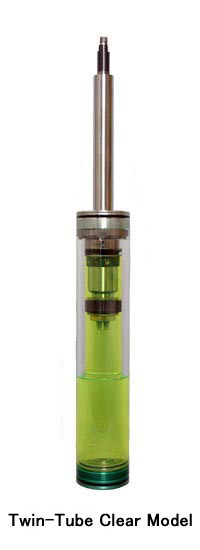 Merits *It is easier to secure sufficient stroke, because the oil and gas chambers are separated and not positioned serially. *The base valve enables to keep gas pressure low, allowing for a more comfortable ride. *Low gas pressure avoids stress on seals and keeps friction levels low. *Compared to the inverted type, friction can be suppressed. *Even if the shell case is slightly damaged, the function of the shock absorber remains unaffected. *Superior manufacturing processes allow to keep production costs low. Demerits *Oil capacity is not as large as the mono-tube. *Size of the piston valve is not as large as the mono-tube. *The structure restricts installation angles. *The oil and gas chambers are not separated, so there is a possibility for aeration to occur. Did you understand the merits and demerits of the mono and twin-tubes? Now, let’s directly compare the mono and twin-tubes. 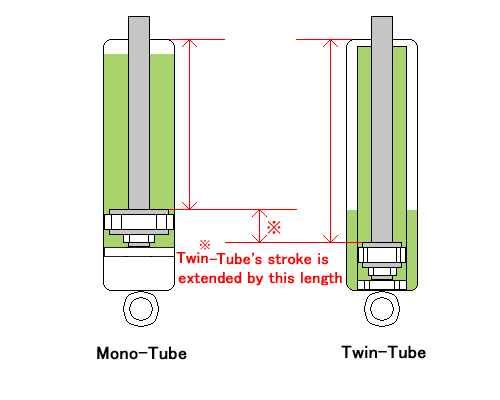 1. Ride quality of street shock absorber. Some manufacturers say the mono-tube is superior to the rest, but is it really true? Let’s take a look back at the demerits of the mono-tube. *Maintaining sufficient stroke is difficult because the oil and gas chambers are positioned serially. * Due to the high-pressure gas injection structure, there is a tendency for a stiffer ride. *Due to high-pressure gas injection, high stress is put on seals and friction increases. *Compared with the upright type, the inverted type tends to have more friction, because it has more moving parts with one stroke. *If the shell case is damaged, the inner cylinder is directly affected. In recent years, the importance of ride quality has become essential for street shock absorbers. To ensure optimal ride quality with street shock absorbers, it is vital to have the correct settings, but also sufficient stroke. Within the mono-tube, oil and gas chambers are divided and distributed serially, and when comparing it with the same length twin-tube, it can not ensure sufficient stroke. If you have a race shock absorber, designed for flat surfaced circuits, you don’t require as much stroke length as a street shock absorber, which has to deal with uneven surfaces and other conditions. There is a direct link in experiencing deteriorated ride, such as sudden jolts etc, for street shock absorbers and not securing sufficient stroke. 2. What is the high-pressure gas ? Similar to the insufficient stroke problem, the high-pressure gas injection creates a stiffer ride, enlarges friction etc. and is the main reason for deteriorating ride quality. Some manufacturers have the base valve positioned above the free piston to lower the high-pressure gas injected. But this results in even further sacrifice in stroke space and a tendency to reverse the effect. 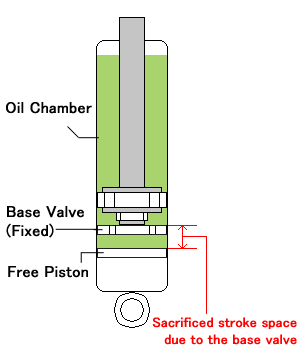 【Reference】 Why the mono-tube requires high pressure gas injection. The twin-tube shares and creates the expanding/ contracting damping force with the piston and base valves, so there is no need for high-pressure gas injection. However, the mono-tube creates the expanding/ contracting damping force with just the piston valve. The mono-tube stroke action occurs when the free piston moves in the space created by the contracting piston rod. During this action, if there isn’t enough pressure on the free piston, it will easily move, over contracting and accurate contracting damping force will not be achieved. For this reason, there needs to be enough high-pressure gas injected into the gas chamber to control the free piston. When you inject high-pressure gas into the gas chamber, according to Pascal’s law, there will be an equal amount of gas pressure supplied to the amount of shock sustained. When this happens there will be high pressure applied on the oil seal, and the restraining force on the seal will increase therefore also increasing friction. 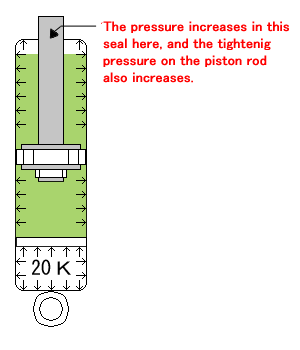 When there is low gas pressure.  When there is appropriate gas pressure  3. Which is better suited for the street ? 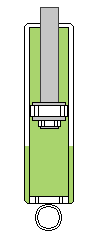 You never know what is lying on the surface of a regular road. If something strikes the shock absorber and damages the shell case, the mono-tube, which is constructed of only one inner cylinder, will not be able to perform its stroke action. If you think about it, can you really say the mono-tube design is optimal for the street? I'm afraid the answer is "NO". Let's take a look back at the merits of the twin-tube. *It is easier to secure sufficient stroke, because the oil and gas chambers are separated and not positioned serially. *The base valve enables to keep gas pressure low, allowing for a more comfortable ride. *Low gas pressure avoids stress on seals and keeps friction levels low. *Compared to the inverted type, friction can be suppressed. *Even if the shell case is slightly damaged, the function of the shock absorber remains unaffected. The twin-tube design can answer all the street shock absorber problems. Furthermore, if you compare it with the mono-tube, it has lower costs due to superior manufacturing processes. Other extremely important factors are high quality and reasonable price. In other words, the optimal design for the street is the twin-tube. 4. Mono-tube for the Circuit. Next let’s compare them for the circuit. For the street, the mono-tube’s demerits stand out, but on the circuit, its full potential is exhibited. Let’s take a look back at the merits of the mono-tube.  *Stable damping force can be generated, because of the larger oil capacity and improved heat dissipation. *The larger sized piston valve creates a wider area to receive pressure, and even microscopic damping force can be achieved. *The structure allows no restrictions in installation angles. *Oil radiates heat easier as the temperature increases. *Aeration doesn’t occur because oil and gas are completely separated. For the shock absorber, racing on a circuit is an extremely rigorous environment. When racing continuously for long hours, the shock absorber, itself will generate a lot of heat. The nearby brake gives off even more, generating heat close to 1000 degrees. The shock absorber feels the full effects of this heat. For this reason, even when driven hard for long hours, it is vital for circuit shock absorbers to perform consistently. So it’s the mono-tube’s merits that are naturally suited for hard driven circuits. The stroke problem is not really a concern at the circuit because the flat surfaces and high spring rates don’t require as much stroke action as on the street. This is why the mono-tube design is better suited for the circuit. The twin-tube design.... *Structurally, the oil capacity is lower than the mono-tube. *Structurally, the piston valve cannot be larger than that of the mono-tube. *Structurally, the shell case cannot be inverted for strut type suspension. *Aeration may occur because the oil and gas chambers are not separated. Unfortunately we cannot say that it is suited for the hard circuit conditions because of these demerits. But when we say the twin-tube is not suited for circuits, it is only based on direct comparisons with the mono-tube. Last edited by Fishey; 02-21-2013 at 01:47 PM. |
|
|

|
|
|
#4 (permalink) |
|
A True Z Fanatic
 Join Date: Nov 2011
Location: Houston
Posts: 12,265
Drives: 2011 370ztt
Rep Power: 29539            |
You can overcome the low fluid capacity issue of the twin tubes by finding one that has external reservoirs. Of course, those seem to be among the more expensive options.
__________________
2011 MB Touring-Sport-6sp-Nav/GTM TT/FI TT TDX/JTran/Kosmic/Eibach/Hotchkis/SPC/CSF/RPS/SoThatsWhereAllMyMoneyWent |
|
|

|
|
|
#5 (permalink) |
|
A True Z Fanatic
 Join Date: Feb 2011
Location: Irvine
Posts: 1,682
Drives: 13 PW sport 6mt
Rep Power: 19           |
^^^ THat was the article that I was thinking of. I saw the same thing in another thread. Like I said, very informative but hard to apply real world when comparing say, monotube-monotube. Like you mention in the very beginning, not all monotubes are constructed the same and this is a very general article on which performs better in certain situations.
But if you get into specifics between different monotube solutions there seems to be no readily available way to tell which one is better other than the brand name and cost. One would assume the higher cost yields you a finer result and more robust product, however, many of us know that is simply not always the case. Is there a way to determine quality between coilovers of different brands but similar design (mono, twin, etc). |
|
|

|
|
|
#6 (permalink) | |
|
Base Member
Join Date: Sep 2012
Location: Lebanon
Posts: 159
Drives: Volvo T5-R
Rep Power: 13    |
Quote:
Last edited by Fishey; 02-21-2013 at 02:00 PM. |
|
|
|

|
|
|
#7 (permalink) |
|
A True Z Fanatic
 Join Date: Feb 2011
Location: Irvine
Posts: 1,682
Drives: 13 PW sport 6mt
Rep Power: 19           |
For someone like me who really can't tell the difference between coils other than what I know from the Tein article, Stance does a really great job of getting my attention:
Pro Comp What's really compelling to someone like me is that little star graph they have on the left side of the page telling you what these coils are good for, (drift, time attack, etc). I really want them because of the graph but there are two problems: 1. no point of reference to qualify the graph 2. more importantly they don't make their competition coils for the 370z. LOL I know stance has cheapy coils for the 370z but it's not of the same build quality, I assume, as their competition models. |
|
|

|
|
|
#8 (permalink) | |
|
A True Z Fanatic
 Join Date: Feb 2011
Location: Irvine
Posts: 1,682
Drives: 13 PW sport 6mt
Rep Power: 19           |
Quote:
Like someone mentioned above, as far as I can tell any high end coil will do what you want it to do as long as it's adjusted properly for the application. In the end perhaps I'm asking the wrong question. Perhaps it's more a question of what are the best settings to use on the track; but that's a whole different can of trolls, erp, worms. 
|
|
|
|

|
|
|
#9 (permalink) |
|
A True Z Fanatic
Join Date: May 2010
Location: nirvana
Posts: 6,394
Drives: 2023 NATM
Rep Power: 419            |
The short answer is:
If you want them for the track, and fully adjustable, you will probably have to go high end (e.g., Bilstein, Ohlins), otherwise you tend to find mismatched valving, random spring rates, adjustability controls that either do little or even have the opposite effect desired. If you are serious about it, get high end ones, and then get them adjusted on a shock dyno. Off the rack wil be a mystery without data for that specific set of shocks and springs. Or... if you just want something reliable and suitable for day-to-day driving, I recommend not bothering with coil overs and just something basic like Koni yellows and, say, swift springs. Why get adjustable coilovers if you intend to set it and forget it and just drive on the street?
__________________
Enjoy it. Destroy it. |
|
|

|
|
|
#10 (permalink) |
|
A True Z Fanatic
 Join Date: Feb 2011
Location: Irvine
Posts: 1,682
Drives: 13 PW sport 6mt
Rep Power: 19           |
So is there a huge difference between different high end coils? Is there something that KW has the Bilstein or BC does not and vice versa? Or does it all come down to price in the end? At the high end stage does application even matter (going back to the assumption that high end coils can do it all and are dependant on settings more so than the product itself).
I do plan on putting this car on track duty for the long term but I will be driving it on the street as well. Personally I'm not terribly concerned with how comfortable it is but I will have to drive it two or three hours on the road every time I take it to the track. |
|
|

|
|
|
#12 (permalink) |
|
A True Z Fanatic
|
usually speaking if you are going high end (external reservoirs, 3+ way adjustable, etc), chances are you have more than a rough understanding of what you need.
For most people a street application coilover is more than enough. I'd say look for a brand with a good reputation and go from there depending on your needs and if you have a preference in brand and such.
__________________
Last edited by KamiSpeed; 02-23-2013 at 06:17 AM. |
|
|

|
|
|
#13 (permalink) |
|
A True Z Fanatic
Join Date: Apr 2012
Location: SoCal
Posts: 6,243
Drives: WELL ZED PW 6MT
Rep Power: 53242            |
Hey Denny. If you are still in the market or researching, give Charles Park from powertrix a call. Just talk to the guy and see what he says. The advantage is he is local and can service your car's suspension if you need it.
Supporting a forum sponsor too.
__________________
 >MyZ's Album< NISMO Convert/ECUTEK/Takeda CAI/F.I. HFC NR CB Carbon/F.I. 34 Row Oil Cooler/4.08 Final Drive /Powertrix+Swifts/Hotchkis/SPL/Whiteline/TWM/Zoom Engineering/EVO-R/AeroJacket Vented CF Fenders + CF Spoiler/Avant Garde-WORK/NST/Morimoto Halo/STi Clear Lenses/Carbon Signal Automotive/RJM Performance/ZSpeed Clutch Flywheel CSC delete
Last edited by axmea?; 09-30-2013 at 10:51 PM. |
|
|

|
|
|
#14 (permalink) |
|
The370Z.com Sponsor
|
Great thread guys. We've been road racing and in the car enthusiasts scene since the late 90s. It pains us to see kid buying all the BC/Fortune/Etc cheap knockoffs. The shock dynos on any of the $1000 coilovers is so inconsistent and awful it is actually worse than driving on your OEM setup. Lower your car too much and you actually make handling worse because you lose upward travel.
Our breakdown over the years has come down to this: Street/Show- Springs and Struts or BC/Fortune/Knockoff-o-rama Entry level HPDE- KWs or Bilsteins Top Level HPDE/Entry Level Race- AST Club Racing- Moton Beyond that- Penske -Mike Paisan     Maintaining, Modifying and Educating TriState Enthusiasts since 2001. Now we have an Online Catalog where you can purchase Parts! AZPParts.com Like us on Facebook! | E-mail: sales@azpinstalls.com | 725 Fairfield Ave | Kenilworth, NJ 07033 | 908.248.AZP1 (2971) |AIM: AZP Installs "Race Tested, Enthusiast Approved!" |
|
|

|
|
|
#15 (permalink) | |
|
Track Member
 Join Date: Oct 2011
Location: South Florida
Posts: 882
Drives: 12 PW 370z 6MT Sport
Rep Power: 15       |
Quote:
__________________
2012 Pearl White 370Z GReddy Twin Turbo 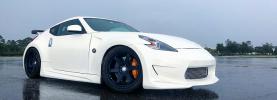 |
|
|
|

|
 |
| Bookmarks |
|
|
 Similar Threads
Similar Threads
|
||||
| Thread | Thread Starter | Forum | Replies | Last Post |
| [FOR SALE] Coilovers | pokeyl | Parts for sale (Private Classifieds) | 20 | 04-13-2012 02:28 PM |
| [FOR SALE] BC BR coilovers | Xsad | Parts for sale (Private Classifieds) | 8 | 01-29-2012 02:15 PM |
| great info about coilovers vs springs..i may jus save up for coilovers instead | res0zsfa | Brakes & Suspension | 15 | 09-09-2010 07:05 PM |
| Coilovers for Z | Red__Zed | Brakes & Suspension | 24 | 08-17-2010 09:11 AM |
| D2 coilovers for my z?? | hittindabong | Brakes & Suspension | 13 | 02-18-2010 08:48 PM |